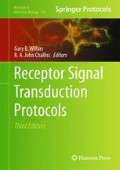Abstract
G protein-coupled receptors (GPCRs) play a key role in the regulation of physiological functions. Deregulation of their activities often results in pathological disorders and therefore these receptors constitute major targets for drug development. The emergence of new concepts such as GPCR oligomerization has modified our understanding of these proteins, and identifying the role of receptor complexes is probably a major challenge for the next decade. Various experimental strategies have been developed to study GPCR oligomers and energy transfer experiments between partners within a complex constitute one of the most convenient approaches. These experimental strategies usually require receptor fusion to tags or fluorescent or luminescent proteins and therefore cannot be easily applied to native tissues. We developed a new experimental approach based on the labeling of receptors with high affinity fluorescent ligands compatible with time-resolved energy transfer measurements. Because of the very high signal-to-noise ratio of the time-resolved fluorescent energy transfer (TR-FRET) signals, this approach constitutes a breakthrough since it allows the direct identification of wild-type GPCR oligomers in native tissues.
Access this chapter
Tax calculation will be finalised at checkout
Purchases are for personal use only
References
Milligan, G. (2004) G protein-coupled receptor dimerization: function and ligand pharmacology. Mol. Pharmacol. 66, 1–7.
Terrillon, S. and Bouvier, M. (2004) Roles of G-protein-coupled receptor dimerization. EMBO Rep 5, 30–34.
Gomes, I., Gupta, A., Filipovska, J., Szeto, H.H., Pintar, J.E., and Devi, L.A. (2004) A role for heterodimerization of mu and delta opiate receptors in enhancing morphine analgesia. Proc. Natl. Acad. Sci. U. S. A. 101, 5135–5139.
Fotiadis, D., Jastrzebska, B., Philippsen, A., Muller, D.J., Palczewski, K., and Engel, A. (2006) Structure of the rhodopsin dimer: a working model for G-protein-coupled receptors. Curr. Opin. Struct. Biol. 16, 252–259.
Roess, D.A., Horvat, R.D., Munnelly, H., and Barisas, B.G. (2000) Luteinizing hormone receptors are self-associated in the plasma membrane. Endocrinology 141, 4518–4523.
Urizar, E., Montanelli, L., Loy, T., Bonomi, M., Swillens, S., Gales, C., Bouvier, M., Smits, G., Vassart, G., and Costagliola, S. (2005) Glycoprotein hormone receptors: link between receptor homodimerization and negative cooperativity. EMBO J. 24, 1954–1964.
Waldhoer, M., Fong, J., Jones, R.M., Lunzer, M.M., Sharma, S.K., Kostenis, E., Portoghese, P.S., and Whistler, J.L. (2005) A heterodimer-selective agonist shows in vivo relevance of G protein-coupled receptor dimers. Proc. Natl. Acad. Sci. U. S. A. 102, 9050–9055.
Wreggett, K.A. and Wells, J.W. (1995) Cooperativity manifest in the binding properties of purified cardiac muscarinic receptors. J. Biol. Chem. 270, 22488–22499.
Angers, S., Salahpour, A., and Bouvier, M. (2002) Dimerization: an emerging concept for G protein-coupled receptor ontogeny and function. Annu. Rev. Pharmacol. Toxicol. 42, 409–435.
Bazin, H., Trinquet, E., and Mathis, G. (2002) Time resolved amplification of cryptate emission: a versatile technology to trace biomolecular interactions. J. Biotechnol. 82, 233–250.
Albizu, L., Balestre, M.N., Breton, C., Pin, J-P., Manning, M., Mouillac, B., Barberis, C., and Durroux, T. (2006) Probing the existence of G protein-coupled receptor dimers by positive and negative ligand-dependent cooperative binding. Mol. Pharmacol. 70, 1783–1791.
Maurel, D., Kniazeff, J., Mathis, G., Trinquet, E., Pin, J.P., and Ansanay, H. (2004) Cell surface detection of membrane protein interaction with homogeneous time-resolved fluorescence resonance energy transfer technology. Anal. Biochem. 329, 253–262.
Maurel, D., Comps-Agrar, L., Brock, C., Rives, M-L., Bourrier, E., Ayoub, M.A., Bazin, H., Tinel, N., Durroux, T., Prézeau, L., Trinquet, E., and Pin, J-P. (2008) Cell-surface protein-protein interaction analysis with time-resolved FRET and snap-tag technologies: application to GPCR oligomerization. Nat. Methods 5, 561–567.
Albizu, L., Cottet, M., Kralikova, M., Stoev, S., Seyer, R., Brabet, I., Roux, T., Bazin, H., Bourrier, E., Lamarque, L., Breton, C., Rives, M.L., Newman, A., Javitch, J., Trinquet, E., Manning, M., Pin, J. P., Mouillac, B. and Durroux, T. (2010) Time-resolved FRET between GPCR ligands reveals oligomers in native tissues. Nat. Chem. Biol. 6, 587–594.
Middleton, R.J. and Kellam, B. (2005) Fluorophore-tagged GPCR ligands. Curr. Opin. Chem. Biol. 9, 517–525.
Acknowledgements
Thanks are due to Dr. L. Prezeau for his critical reading of the manuscript. This work was supported by research grants from CNRS, INSERM, ACI Molécules Cibles et Thérapeutiques (no. 240 and 355), ANR (06-Blanc-0087-03). Thanks to Plate-forme de Pharmacologie-Criblage Interactome of Montpellier and the Region Languedoc-Roussillon for making this work possible.
Author information
Authors and Affiliations
Corresponding author
Editor information
Editors and Affiliations
Rights and permissions
Copyright information
© 2011 Springer Science+Business Media, LLC
About this protocol
Cite this protocol
Cottet, M. et al. (2011). Time Resolved FRET Strategy with Fluorescent Ligands to Analyze Receptor Interactions in Native Tissues: Application to GPCR Oligomerization. In: Willars, G., Challiss, R. (eds) Receptor Signal Transduction Protocols. Methods in Molecular Biology, vol 746. Humana Press, Totowa, NJ. https://doi.org/10.1007/978-1-61779-126-0_21
Download citation
DOI: https://doi.org/10.1007/978-1-61779-126-0_21
Published:
Publisher Name: Humana Press, Totowa, NJ
Print ISBN: 978-1-61779-125-3
Online ISBN: 978-1-61779-126-0
eBook Packages: Springer Protocols

